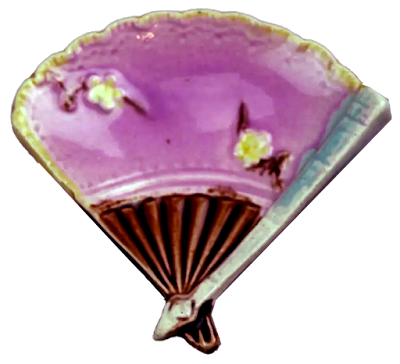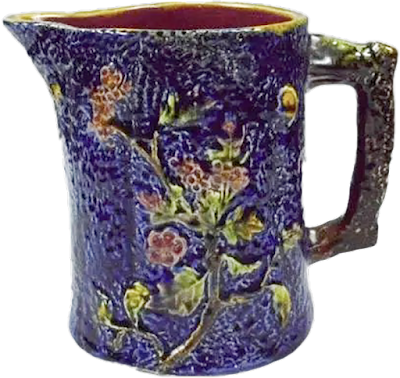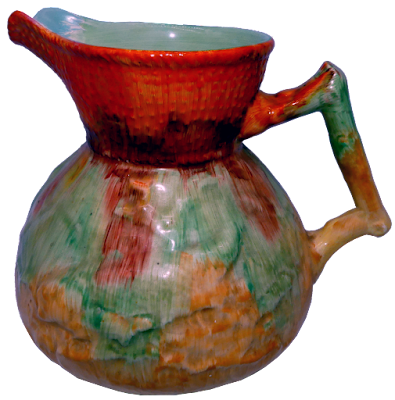There are issues in approaching the narrative history of the majolica of Shorter and Boulton. One is the history itself. The company saga is a complex one involving a number of different failed partnerships before establishing success in the majolica market. Then there are the later acquisitions that expanded Shorter’s operations and the ownership and name changes that resulted.
Unfortunately, the issue of attribution may be even more complex. Shorter & Boulton rarely marked their wares. Many Shorter & Boulton designs were heavily copied by other potteries. Arsenal, Eureka and Willits in the United States have had copies of Shorter & Boulton designs attributed to them. In England, Forester and Fielding are thought to have copied them as well. The previously mentioned later acquisitions which shared the company molds add to the confusion. The only guarantee to attribution for a particular piece is the presence of an English registration mark which is rarely seen. For the sake of illustration here in this blog, I will be showing pieces believed to have been designed by Shorter & Boulton though the particular examples shown may well have been manufactured by others.
Let’s begin with the history of founder Arthur Shorter. Shorter was born in 1850, the sixth of seven children. His father Jabez Shorter was a train station master who owned a small interest in a pottery in Longton. After a brief apprenticeship with his father as a railway clerk, his innate artistic talent led Arthur to a career as a ceramics decorator at the firm of Hope & Carter in Burslem. With this experience he became an apprentice at Minton & Co. and later Bodley & Co.
Around 1872 Jabez Shorter set up his two sons, Arthur and William as china dealers in Stanford. The partnership lasted until 1874 when Arthur left the company to partner with Frances Dean, William Lowe and Herbert Machin to form the pottery of Dean, Lowe, Machin & Shorter at the Parker Street Works in Hanley. After two years that partnership dissolved and Shorter established a short partnership with Robert Horne to form Shorter & Horne. That company dissolved in 1878 and the Hanley pottery and its contents were sold.
In 1878 Shorter established yet another partnership, this time with Joseph Bettelley and William Millward. With money derived from the sale of the Hanley pottery, Shorter, Bettelley, Millward & Co. set up business at the small Batavia Works on Copeland Street in Stoke upon Trent. James Boulton—who had experience at Wedgwood—was also part of this firm, working as an experienced oven operator. The partnership was brief as Bettelley and Millward left the company and the partnership was dissolved in November 1878. James Boulton then became Shorter’s new partner and the firm of Shorter & Boulton was founded in late 1878.
During the 1870s, Arthur Shorter married Henrietta Wilkinson. Henrietta was the sister of A.J. Wilkinson who went on to establish his own pottery in Burslem in 1885. This would prove to be greatly influential in the future history of Shorter & Boulton.
The new company of Shorter & Boulton produced a variety of different wares, but majolica was a popular commodity in Victorian England so by 1879 the company entered the majolica market in a big way, soon becoming their main focus. Thanks to Arthur Shorter's brother John–who had immigrated to Australia–the company established a strong export business to Australia, with John handling sales. This export business grew to include other ports within the British Empire as well as the huge ceramics market in the United States where majolica was in high demand. A large export market guaranteed the company’s success where the others had failed.
Most of their designs had a strong Asian influence. One of the company’s earliest registered majolica designs is Fan, shown below.
Numerous fan shaped designs were created to coordinate with this pitcher the best known of which is the Fan ice cream series. Heavily copied in the United States, the Shorter & Boulton pieces are usually difficult to distinguish from the American copies.
There is also tea ware, dessert wares and decorative items of all kinds with the fan theme.
In 1891 Henrietta Wilkinson's brother Arthur died from a fall, leaving the A.J. Wilkinson pottery without management. Arthur Shorter left Shorter & Boulton to helm the A.J. Wilkinson pottery and the reins of management at Shorter & Boulton fell to James Boulton.
Wilkinson’s pottery specialized in white granite ware as well as other earthenware. In 1894, Shorter purchased the Wilkinson pottery and with the retirement three years later of James Boulton, combined ownership of the two firms. The two companies shared production and molds though management continued separate with James' son William assuming duties at Shorter & Boulton and Shorter's sons Collie and Guy at Wilkinson's.
In 1906 William Boulton left the firm and the name of the firm of Shorter & Boulton was changed to Shorter & Son. The company continued producing large quantities of majolica under the Shorter & Son name. Arthur Shorter retired in 1918 leaving the management of the two potteries to his sons. In 1920 the brothers expanded the pottery with the purchase of the Newport Pottery, which was later to become the headquarters of Clarice Cliff ceramics.
Around this time the customer interest in majolica had diminished so the Shorters lessened its production in favor of more contemporary wares. Majolica still, however, continued to be part of Shorter & Son’s output. The majolica production at Shorter had a long run, beginning in 1879 and continuing through the beginning of WW2.
Clarice Cliff began her career as a decorator at Wilkinson. She caught the eye of the married Collie Shorter with whom she had an affair. Her interest in contemporary decoration incentivized Shorter to set her up at her own business at the newly purchased Newport Pottery. She exerted considerable influence over the lines produced at the three Shorter owned potteries. In 1939 Collie’s first wife Annie died. Clarice married Collie Shorter the following year.
She went on to use some of the Shorter & Boulton molds in her lines as well as create her own shapes. Below are Wilkinson/Newport jugs issued under the Clarice Cliff name using Shorter & Boulton molds.
As mentioned earlier Shorter & Boulton marked almost none of their production. Reverses are often glazed in a washed grey glaze. Impressed diamond marks appear on the few designs submitted to the English Registration office.
After the name change to Shorter & Son in 1906 they usually marked their wares using ink marks and occasionally molded marks. It’s from this later production that we have much of the information regarding Shorter & Boulton's output. Reverses on these later pieces are usually glazed in ivory.
Shorter became known for producing reasonably priced majolica. Some Shorter & Boulton majolica molds continued to be used at the Shorter, Newport and Wilkinson potteries through the remaining history of the potteries using non majolica glazes.
The company continued in operation until 1963 when it merged with Fieldings. Production was then absorbed by the Crown Devon pottery. That pottery finally closed in 1974.































































































No comments:
Post a Comment